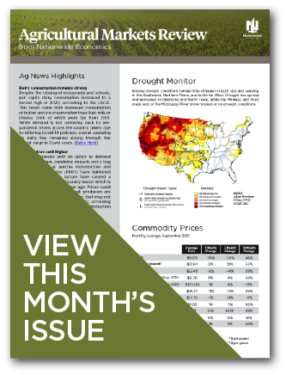Threats to corn yields are emerging
Threats to corn yields are emerging
Well-publicized wildfires in Canada have, at least to some extent, become an emerging threat to the U.S. corn crop. If the smoke now covering several states is dense enough for an extended period, the decreased sunlight could negatively impact photosynthesis. The deficit in photosynthesis would force the plants to utilize carbohydrates from their stalks for food, which would ultimately weaken the stalks and leave them susceptible to stalk rot pathogens. However, this is only a minor concern as a result this extreme is unlikely. It’s probable that enough diffused light would reach the plants through the smoke to ensure growth, assuming there is adequate soil moisture to keep the pores in the leaf open.

Of greater concern to the U.S. corn crop than reduced sunlight is poor soil moisture due to drought conditions currently covering much of the midwest and Plains (e.g., from South Dakota, Nebraska and Kansas in the west through New York in the east), and it’s possible the smoke from the wildfires could exacerbate the current dry conditions.
According to USDA meteorologist Brad Rippey, “The smoke is dense enough in the Northeast that we’re seeing where thunderstorms and showers are being suppressed by the extremely dense smoke at all levels of the atmosphere. We’ve had a blocking high-pressure system (parked over Canada) for much of the month of May and into June, and that can lead to the dry conditions in the Midwest and have an impact on crop yield and production.”
Corn prices fell in May to their lowest level since January 2022 at just above $6.00 per bushel. Although low compared to recent history, spot prices remain more than 40 percent higher than the long-run average. It’s too early to know if these threats to the U.S. corn crop will eventually take a toll, but they are worth keeping an eye on as a negative impact on crop condition or yields would prompt a renewed rise in corn prices. There is currently no direct forecast on the possible impact on prices from these events.
Ag News Highlights
Pork production costs have soared
Input costs for pork production have risen dramatically during this high-inflation period, leading to a tough outlook for pork producers. Breakeven costs are around $90 per cwt through 2024, according to Steve Meyer of Partners for Production Agriculture and Ever.Ag — roughly 50 percent higher than they were prior to 2020. Unfortunately, prices received for pork have not risen nearly as much in that time.
Dermot Hayes, economics professor at Iowa State University, suggests that some level of sow liquidation has already taken place as a cost-cutting measure, and that more seems likely going forward.
“Something has to happen,” he said. “Something has to give. We’re not going to stay losing $40 an animal for 10 years. And what I think is going to give, especially some of the larger units, are cutting their sow numbers.”
There was a spike in demand for pork in 2021 and 2022 due to pandemic-related stimulus in the pockets of consumers and decreased restaurant activity. With that scenario unlikely to repeat, the pressure for expanding pork demand falls on exports. Barring sizable growth in export demand (which is already strong), pork producers could be headed for some tough decisions.1
Ag Barometer plummets in May
The Purdue University/CME Group Ag Barometer fell sharply to a six-month low of 102 in May. The fall was due to a drop in both the current conditions and future expectations indices, although future expectations took a more pronounced hit as pessimism grew over the direction of crop prices. The percent of farms expecting weaker financial performance in the coming 12 months rose dramatically from April.
While the top financial concern for farmers remains high input costs, lower output prices have become an increasing worry this year — more than a quarter of respondents named it their top concern compared to just eight percent in September. This third-most frequent response for top concern was interest rates; nearly 60 percent of producers expect interest rates to rise further and negatively impact their borrowing power in the year ahead.2
Citations/Disclaimers
-
1
-
The information in this report is provided by Nationwide Economics and is general in nature and not intended as investment or economic advice, or a recommendation to buy or sell any security or adopt any investment strategy. Additionally, it does not take into account any specific investment objectives, tax and financial condition or particular needs of any specific person.
The economic and market forecasts reflect our opinion as of the date of this report and are subject to change without notice. These forecasts show a broad range of possible outcomes. Because they are subject to high levels of uncertainty, they will not reflect actual performance. We obtained certain information from sources deemed reliable, but we do not guarantee its accuracy, completeness or fairness.


